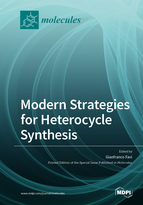Modern Strategies for Heterocycle Synthesis
A special issue of Molecules (ISSN 1420-3049). This special issue belongs to the section "Organic Chemistry".
Deadline for manuscript submissions: closed (30 September 2019) | Viewed by 78785
Special Issue Editor
Interests: organic synthesis; heterocyclic chemistry; C-H activation; cyclization; michael addition; photochemistry
Special Issues, Collections and Topics in MDPI journals
Special Issue Information
Dear Colleagues,
Heterocycles feature widely in natural products, agrochemicals, pharmaceuticals and dyes and their synthesis is of great interest to synthetic chemists in both academia and industry. Contributions on recent applications of new methodologies in C–H activation, photoredox chemistry, cross-coupling strategies, borrowing hydrogen catalysis, multicomponent and solvent-free reactions, regio- and stereoselective syntheses, as well as other new, attractive approaches for the construction of heterocyclic scaffolds would be of great interest. This Special Issue is dedicated to featuring the latest research that is ongoing in the field of heterocyclic synthesis. It is expected that most submissions will focus on five- and six-membered oxygen and nitrogen-containing heterocycles, but structures incorporating other rings/heteroatoms will also be considered. Original research (communications, full papers and reviews) that discuss innovative methodologies for assembling heterocycles with potential application in materials, catalysis and medicine are therefore welcome.
Dr. Gianfranco Favi
Guest Editor
Manuscript Submission Information
Manuscripts should be submitted online at www.mdpi.com by registering and logging in to this website. Once you are registered, click here to go to the submission form. Manuscripts can be submitted until the deadline. All submissions that pass pre-check are peer-reviewed. Accepted papers will be published continuously in the journal (as soon as accepted) and will be listed together on the special issue website. Research articles, review articles as well as short communications are invited. For planned papers, a title and short abstract (about 100 words) can be sent to the Editorial Office for announcement on this website.
Submitted manuscripts should not have been published previously, nor be under consideration for publication elsewhere (except conference proceedings papers). All manuscripts are thoroughly refereed through a single-blind peer-review process. A guide for authors and other relevant information for submission of manuscripts is available on the Instructions for Authors page. Molecules is an international peer-reviewed open access semimonthly journal published by MDPI.
Please visit the Instructions for Authors page before submitting a manuscript. The Article Processing Charge (APC) for publication in this open access journal is 2700 CHF (Swiss Francs). Submitted papers should be well formatted and use good English. Authors may use MDPI's English editing service prior to publication or during author revisions.
Keywords
- organic synthesis
- heterocyclic chemistry
- synthetic methods
- annulations
- C–H activation
- photoredox chemistry
- multicomponent reactions
- solvent-free reactions
- cross-coupling reactions
- chemo-, regio-, and stereoselective syntheses
- chemical space of heterocycles







